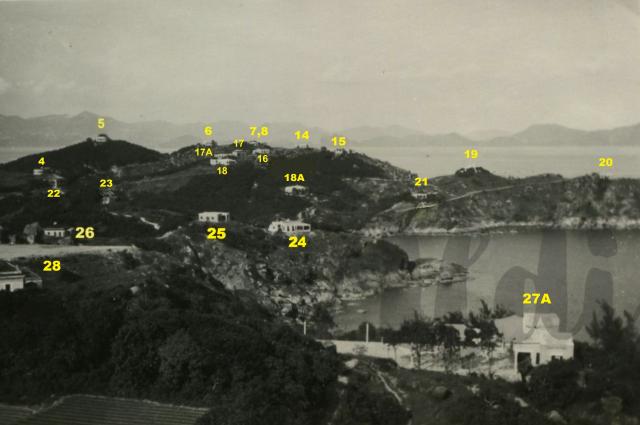The Clifts, along with other European missionaries, owned/ rented a bungalow on Cheung Chau, starting sometime before 1915, to which they retreated in the hot summer months. Favoured locations for bungalows were the tops of the rises on the island, which nicely caught the cool sea breezes and afforded pleasing views. It was a cheaper alternative to the coolness of The Peaks and like the Peaks Cheung Chau had its own 'Peak' area*.
After the Clifts finally moved to Hong Kong from Nanning, China, around 1930, the bungalow was an invaluable retreat for their day of rest each week. They found from experience that only by being physically absent from the Medical Centre could they guarantee a break from the constant demands of a needy population. And as Sundays were busy with their Mission Church, they settled on Thursdays as their rest day and duly took the ferry each week for the hour's trip to the island and their bungalow there.
Their bungalow was #18A at Nam Tam Wan. In this picture we're looking NE towards Lamma Island and Hong Kong Island beyond. It seems the Clifts also owned/ rented house #28 during the 1930s.
The Clifts' garden offered fragrance and a cool retreat. Dr Clift enjoyed gardening and had a great interest in the cultivation of tropical and rare plants. So bougainvillea, night-flowering cerias, masses of double spider lilies, zinnias and orchids were all to be found.*
* Jill Doggett: The Yip Family of Amah Rock

Comments
Similar View
For comparison, a similar view previously posted.
Similar View
Thank you. Most interesting to read Tung Lin's post which says, 'There were missionaries, mostly in transit or in vacations, lived in some of the houses in the picture.'
It would be interesting to see what it looks like now. I'm hoping someone has a pic.
Edit: Pleased to find this pic on Gwulo for the view today. Glad to see it's not totally overbuilt. A lot more woodland in evidence. I guess back in the 30s a lack of woodland would be due to depradations for cooking and heating.
Post moved, please delete.
Post moved, please delete.
'The Peak' Cheung Chau
Jill Doggett in her Yip Family book says that Cheung Chau had its own 'Peak' area in the 30s in the southern part of the island. Does this still exist today?
Re: Peak Area on Cheung Chau
Yes it does. The “Peak” area is on the southern part of the island. There is a Peak Road that leads to the older missionary houses.
Please delete no longer needed
Help! Looking at other posts I fear I may have got things wrong. Is the house I've marked #27, #27 or #28 please? I think it should be 28.
Edit - I've made the changes. Please delete this post.